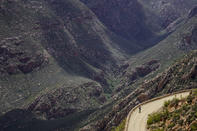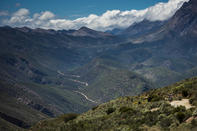Lion's Ravine
Hidden inside a narrow valley, folded away within the Swartberg Mountain massif, is Gamkaskloof. Literally, this translates as ‘Lion’s Ravine’, but the valley is much better known by its derogatory nickname, Die Hel.

For 150 years, Die Hel was arguably the most isolated community on the sub-continent. Surrounded by mountains on the North, South, East and West, residents of this tiny community were entirely cut off from the outside world. When they wanted to leave their valley and go into town, they either had to walk out over the mountains, or ford the Gamka River through a rocky kloof. Likewise, when they wanted to bring something back, like a bed or a stove, it had to be carried in on the back of a farmer, or harnessed to a donkey.
Peaceful Life
Gamkaskloof was a largely self-sufficient community, made up of a handful of pioneer families who had started moving in from the late 1700’s. Most people would have avoided such a remote settlement, but the Klowers were an iconoclastic bunch, attracted by the freedom that comes with isolation.
Many of the original families stuck it out for generation after generation, until the surnames Mostert, Cordier, Swanepoel, Nel and Marais rang through the annals of the valley, like Dlamini’s in a Swaziland phone directory.
Life was peaceful, and the people of Gamkaskloof marched to the beat of a different drummer. In their narrow enclave, tucked away in the formidable fastness of the Swartberg Mountains, the Klowers felt safe and free to make up their own rules. Sure, life was hard and creature comforts were largely unknown, but the valley people were happy and prosperous in their humble way.
A Forgotten Community
For many years, the lonely community of Gamkaskloof tended their farms, which spread out along the narrow valley floor. They farmed sweet Hanepoot grapes, made jams and preserves, and collected wild honey. Slowly, as the families grew in number, a school and a church were also built, using the local mud bricks and reeds from the river.
By the 1930’s, there were probably 120 people living in Gamkaskloof, oblivious to the dictates of the twentieth century. Then, the outside world caught up with Gamkaskloof. First, the Boer commander, Denys Reitz, stumbled into the valley around the turn of the 20th century, while hiding from a British force during the Anglo-Boer War.
He recounted his experiences among the locals in his popular book ‘On Commando’, and piqued the interest of his readers with romantic accounts of a forgotten community, cast adrift in a mountainous backwater.
An Interesting Story
Then, the government came to Gamkaskloof in the form of a local tax collector and stock inspector. One of these men is credited with giving the valley its more-familiar name, ‘Die Hel’, apparently bestowed on the idyllic valley because the collector thought it was hell to trek down into the kloof to do his regular livestock checks.
The Klowers hated the name but it endured, thanks to the successive waves of journalists and photographers who descended the precipitous slopes, eager to get an interesting story. These articles were usually unflattering and supercilious. They characterised the Klowers as backward, in-bred hicks with anachronistic clothes, language and customs. Even modern novels, like Andre Brink’s Duiwelskloof, have indulged in these stereotypes, much to the chagrin of the Klowers descendants.
And, over the years, the people of Gamkaskloof have had to endure much mocking disdain from the outside world. So, not only did the locals have to be hardy and stoical, they had to be thick-skinned too.
A Long-Overdue Road

Despite the occasional cover story in the Rooi Rose magazine, the Klowers’ little piece of paradise was still too remote to be incorporated into the real world, and life continued apace. People still had to hike over the peaks to reach Oudtshoorn or Prince Albert, and this journey was only undertaken in the event of sickness, for commerce or when an unattached Klower had to find someone to marry.
Then, in 1962, everything changed. In that year, the government decided to dam the Gamka River, thus effectively stranding the little community of Gamkaskloof. To make amends, they decided to build a long-overdue road down into Hell.
Armed with nothing more than a bulldozer and a handful of workmen, Koos van Zyl was given the mandate to carve a road from the summit of the Swartberg Pass, along the rolling alpine plains, and down a steep switchback pass to the valley floor. It was dangerous work, and Koos often complained that he had nearly fell, bulldozer and all, ‘gat oor kop, Die Hel in’ (arse over head, into the Hell).
An Escape Route
Ironically, the new access route into the valley quickly turned into an escape route out. Within 20 years, everyone had left Gamkaskloof. The last farmer to abandon his land was Piet Swanepoel, in 1991. Under the cloudless Karoo skies, the abandoned homesteads started crumbling, and farms that had been in the same family for generations became overgrown. It seemed like Die Hel was dead.
Then, a consortium of doctors from nearby towns decided to buy up a few of the farms, and established a private conservancy at one end of the valley. More recently, Cape Nature Conservation bought up most of the other farms and incorporated them into the Swartberg Nature Reserve. Finally, Annetjie Joubert, a native klower, decided it was time to move back home.
Her family farm had not been sold to Cape Nature Conservation, much to the conservation authority’s dismay, and Annetjie returned to her ancestral land to start up a private lodge and a restaurant, called The Devil’s Kitchen. Joubert is now the only genuine local living in Gamkaskloof. Some other original Klowers are also still around, but they are living in the relative modernity of Oudtshoorn, Prince Albert and Calitzdorp.